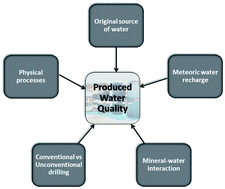Understanding controls on the geochemistry of hydrocarbon produced waters from different basins across the US†
Abstract
The most massive waste stream generated by conventional and unconventional hydrocarbon exploration is the produced water (PW). The costs and environmental issues associated with the management and disposal of PW, which contains high concentrations of inorganic and organic pollutants, is one of the most challenging problems faced by the oil and gas industry. Many of the current strategies for the reuse and recycling of PW are inefficient because of varying water demand and the spatial and temporal variations in the chemical composition of PW. The chemical composition of PW is controlled by a multitude of factors and can vary significantly over time. This study aims to understand different parameters and processes that control the quality of PW generated from hydrocarbon-bearing formations by analyzing relationships between their major ion concentrations, O, H, and Sr isotopic composition. We selected PW data sets from three conventional (Trenton, Edwards, and Wilcox Formations) and four unconventional (Lance, Marcellus, Bakken, and Mesaverde Formations) oil and gas formations with varying lithology and depositional environment. Using comparative geochemical data analysis, we determined that the geochemical signature of PW is controlled by a complex interplay of several factors, including the original source of water (connate marine vs. non-marine), migration of the basinal fluids, the nature and degree of water–mineral–hydrocarbon interactions, water recharge, processes such as evaporation and ultrafiltration, and production techniques (conventional vs. unconventional). The development of efficient PW recycle and reuse strategies requires a holistic understanding of the geological and hydrological history of each formation to account for the temporal and spatial heterogeneities.



 Please wait while we load your content...
Please wait while we load your content...
